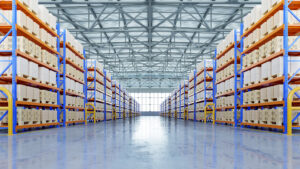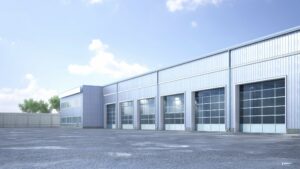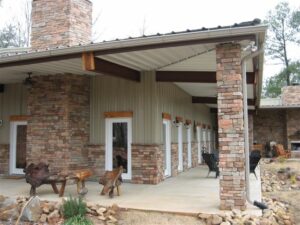When it comes to steel buildings, understanding how to cool a metal building and the cooling system installation cost helps to maintain a comfortable and functional environment.
Cooling is the fastest-growing use of energy in buildings, emphasizing the need for efficient cooling solutions.
Metal structures have unique challenges that need to be addressed when it comes to cooling, and there are various types of cooling solutions available to suit different needs.
In this article, we will explore the need for cooling in metal buildings, the types of cooling solutions available, factors to consider when choosing a cooling solution, installation and maintenance of cooling systems, and the cost analysis of different cooling solutions.
Table of Contents:
- Understanding the Need for Cooling in Metal Buildings
- Types of Cooling Solutions for Metal Buildings
- Factors to Consider When Choosing a Cooling Solution
- Installation and Maintenance of Cooling Systems
- Cost Analysis of Different Cooling Solutions
- Conclusion
- Frequently Asked Questions
Understanding the Need for Cooling in Metal Buildings
Metal buildings are often used for commercial and industrial purposes due to their durability and versatility.
However, their metal construction can pose challenges when it comes to maintaining a comfortable indoor temperature. Metal conducts heat more effectively than other building materials, which means that without proper cooling, metal buildings can become excessively hot in warm weather and retain cold air in the winter. This can lead to uncomfortable working conditions for occupants and potentially damage sensitive equipment.
When considering the design and construction of metal buildings, it is crucial to take into account the need for effective cooling systems. Without proper cooling mechanisms in place, metal structures can experience significant temperature fluctuations, making it challenging to regulate the indoor climate. This not only impacts the comfort of occupants but can also affect the longevity of the building itself.
Pro tip:
Traditional split-system air conditioners, rooftop packaged units, and heat pumps are widely used in metal buildings. These provide controlled temperatures and work in various climates.
The Unique Challenges of Cooling Metal Structures
Cooling metal structures presents unique challenges compared to cooling traditional buildings. Metal has high thermal conductivity, meaning it easily transfers heat from the outside to the interior of the building. This can result in dramatic temperature fluctuations and higher energy consumption if not properly addressed.
In addition to thermal conductivity, metal buildings often have large surface areas that are exposed to direct sunlight, further exacerbating heat absorption. This solar heat gain can significantly impact the indoor temperature of the building, especially during the peak hours of sunlight exposure.
Addressing this challenge requires strategic placement of insulation and the implementation of efficient cooling systems to counteract the effects of solar radiation.
Why Proper Cooling is Essential for Metal Buildings
Proper cooling is essential for metal buildings to ensure the comfort and productivity of occupants. Excessive heat can lead to increased humidity, which can create a breeding ground for mold and bacteria. It can also cause metal components to expand and contract, leading to structural issues over time.
Additionally, a hot and uncomfortable environment can decrease productivity and affect the overall well-being of occupants.
Furthermore, inadequate cooling in metal buildings can result in higher energy costs as cooling systems struggle to maintain a consistent indoor temperature. This inefficiency not only impacts operational expenses but also contributes to environmental concerns related to energy consumption.
By prioritizing effective cooling solutions, metal building owners can create a more sustainable and comfortable indoor environment while reducing long-term maintenance costs.
Types of Cooling Solutions for Metal Buildings
There are various types of cooling solutions available for metal buildings, ranging from passive techniques to active cooling systems.
When considering cooling solutions for metal buildings, it’s important to take into account the specific needs of the structure and its occupants. Factors such as building orientation, insulation levels, and local climate conditions play a crucial role in determining the most effective cooling strategy.
Passive Cooling Techniques
Passive cooling techniques rely on natural forces, such as airflow and shading, to cool the building. Strategies include proper insulation, reflective roof coatings, and natural ventilation through windows or louvers.
These techniques can be effective in maintaining a comfortable indoor temperature without relying on energy-intensive systems.
Another passive cooling technique gaining popularity is the use of green roofs on metal buildings. Green roofs not only provide insulation and reduce heat absorption but also promote biodiversity and improve air quality in urban environments.

Active Cooling Systems
Active cooling systems use mechanical means to regulate the temperature in metal buildings. These systems include air conditioners, evaporative coolers, and heat pumps.
Air conditioners remove heat from the indoor air through a refrigeration cycle, while evaporative coolers cool the air through the evaporation of water. Heat pumps provide both cooling and heating capabilities by transferring heat between indoor and outdoor environments.
Another innovative active cooling system is the use of thermal energy storage. This technology allows metal buildings to store excess cooling capacity during off-peak hours and use it during high-demand periods, reducing energy costs and increasing overall efficiency.
Hybrid Cooling Solutions
Hybrid cooling solutions combine passive techniques with active cooling systems to optimize energy efficiency. For example, a building may utilize natural ventilation during mild weather conditions and switch to mechanical cooling during hotter periods. This approach allows for flexible and cost-effective cooling while minimizing energy consumption.
Integrating smart building technologies, such as automated shading systems and occupancy sensors, can further enhance the performance of hybrid cooling solutions in metal buildings.
These technologies enable real-time adjustments based on environmental conditions and occupancy levels, ensuring optimal comfort and energy savings.
Factors to Consider When Choosing a Cooling Solution
When selecting a cooling solution for a metal building, several factors need to be taken into consideration to ensure optimal performance. It’s not just about keeping the space cool but also about efficiency, sustainability, and cost-effectiveness.
Size and Structure of the Building
The size and structure of the building play a crucial role in determining the cooling requirements. Larger buildings with complex layouts may require multiple cooling units or zoning systems to evenly distribute the conditioned air.
Additionally, the insulation level and airtightness of the building envelope should be considered to minimize energy losses. It’s essential to conduct a thorough assessment of the building’s layout and design to determine the most effective cooling solution.
Moreover, the orientation of the building concerning the sun can impact the heat gain and loss, affecting the overall cooling load. Buildings with large windows facing direct sunlight may require additional shading or tinting to reduce the heat gain and lessen the burden on the cooling system.
Climate and Weather Conditions
The climate and weather conditions of the location where the metal building is situated will influence the cooling needs. Buildings in hot and humid climates may require more powerful cooling systems compared to those in moderate climates.
It’s crucial to consider not only the average temperature but also factors like humidity levels and seasonal temperature variations.
Energy Efficiency and Sustainability
Energy efficiency and sustainability are important considerations for cooling solutions. Opting for energy-efficient systems can significantly reduce operational costs and minimize environmental impact.
Look for systems with high Seasonal Energy Efficiency Ratio (SEER) ratings and Energy Star certifications. Additionally, incorporating renewable energy sources such as solar power to supplement the cooling system can further enhance sustainability efforts.
Furthermore, regular maintenance and servicing of the cooling system are essential to ensure optimal performance and longevity. Neglecting maintenance can lead to decreased efficiency, higher energy consumption, and costly repairs.
It’s important to establish a maintenance schedule and promptly address any issues that arise to keep the cooling system running smoothly.
Did You Know:
Choosing the right color for metal buildings can impact energy efficiency. Lighter colors like whites and pastels can reflect sunlight, reducing heat absorption and potentially lowering cooling costs. Check out this article to learn more: Choosing The Right Colors For Your Metal Building
Installation and Maintenance of Cooling Systems
The installation and maintenance of cooling systems are crucial for their long-term performance and efficiency. Properly installed and well-maintained cooling systems can provide optimal cooling while minimizing energy consumption and operational costs.
When it comes to the installation of cooling systems in metal buildings, there is a choice between professional installation and do-it-yourself (DIY) installation. While some individuals may consider DIY installation to save costs, it is generally recommended to hire professionals for this task.
Professional installers possess the necessary expertise and experience to ensure the correct sizing of the system, proper installation techniques, and compliance with relevant building codes and regulations. Additionally, professional installation helps prevent issues such as leaks, improper airflow, and inefficient operation, which can arise from incorrect installation practices.
Professional Installation vs. DIY
While some individuals may opt for a do-it-yourself installation, it is generally recommended to hire professionals for the installation of cooling systems in metal buildings. Professional installers have the necessary expertise and experience to ensure proper system sizing, installation, and compliance with building codes. Improper installation can lead to performance issues and higher energy consumption.
Moreover, professional installers can provide valuable insights into the best placement of cooling units within the building to optimize airflow and cooling efficiency. They can also recommend additional features such as programmable thermostats or zoning systems to further enhance the performance of the cooling system.
Routine Maintenance for Optimal Performance
Regular maintenance is necessary to keep cooling systems operating at their highest efficiency levels.
This includes cleaning or replacing air filters, inspecting and cleaning coils, checking refrigerant levels, and detecting any potential issues.
Regular maintenance not only improves performance but also extends the lifespan of the system, reducing the need for costly repairs.
In addition to the tasks mentioned, routine maintenance may also involve checking for air leaks in ductwork, calibrating thermostats for accuracy, and ensuring proper drainage to prevent water buildup.
By staying proactive with maintenance, building owners can avoid sudden breakdowns, maintain indoor air quality, and ensure consistent comfort levels throughout the building.
Cost Analysis of Different Cooling Solutions
When considering cooling solutions for metal buildings, it is important to evaluate the costs associated with various options.
Initial Investment and Installation Costs
Active cooling systems generally have a higher initial investment and installation costs compared to passive cooling techniques.
Factors such as the size of the building, the complexity of the installation, and the type of system chosen will influence the overall cost. It is important to consider the long-term benefits and energy savings when evaluating the initial investment.
Long-term Operational Costs
While active cooling systems may have higher upfront costs, they can offer significant long-term energy savings compared to passive techniques.
Energy-efficient systems consume less energy, resulting in lower operational costs over time. It is important to assess the energy efficiency ratings and projected energy consumption of different systems to determine the potential long-term operational costs.
Potential Savings from Energy-Efficient Systems
Energy-efficient cooling systems can provide substantial savings in terms of reduced energy consumption and lower utility bills.
Additionally, some energy-efficient systems may qualify for government incentives or rebates, further reducing overall costs. It is advisable to consult with local energy or utility agencies to explore potential savings options.

Conclusion
Cooling solutions for metal buildings play a crucial role in maintaining comfortable and functional environments.
Understanding the need for cooling in metal structures, exploring different types of cooling solutions, considering key factors when selecting a cooling system, ensuring proper installation and maintenance, and conducting a cost analysis are essential steps to ensure optimal cooling performance.
By carefully considering these factors, metal building owners and occupants can enjoy the benefits of a well-cooled environment while minimizing energy consumption and costs.
SteelCo has 23+ years experience dropshipping customizable steel building materials nationwide from self-storage facilities, warehouses, commercial, industrial buildings and more. As a locally awarded General Contractor, our expertise also extends to comprehensive commercial design-build and construction projects across Georgia. Learn more about our services.
—————————-
Frequently Asked Questions
What is the most efficient way to cool a building?
By incorporating a combination of appropriate insulation, energy-efficient windows and doors, daylighting, shading, and ventilation, it is often possible to maintain a comfortable indoor temperature, reducing the need for excessive air conditioning.
What are the unique challenges of cooling metal structures?
Metal has high thermal conductivity, easily transferring heat from the outside to the interior, and large surface areas are often exposed to direct sunlight, exacerbating heat absorption.
What are the types of cooling solutions available for metal buildings?
Passive cooling techniques include insulation, reflective roof coatings, and natural ventilation. Active cooling systems include air conditioners, evaporative coolers, and heat pumps. Hybrid cooling solutions combine passive and active techniques.
What factors should be considered when choosing a cooling solution?
When selecting an HVAC system for a building, several key factors must be taken into account. These include the size and structure of the building, the local climate and weather conditions, the desired level of energy efficiency and sustainability, and the installation and maintenance costs associated with the system.
What are some tips for installing and maintaining cooling systems in metal buildings?
Hire professionals for installation to ensure correct sizing and compliance with building codes. Regular maintenance, such as cleaning filters, inspecting coils, and checking refrigerant levels, is necessary for optimal performance.
How can I reduce the cost of cooling my metal building?
To reduce cooling costs for a metal building, ensure proper insulation and ventilation, use cool roofing materials and reflective paint, add shade and landscaping, upgrade to energy-efficient windows and doors and HVAC systems, and use interior fans. Install smart thermostats and maintain regular checks on cooling systems for optimal performance and cost savings.
How can I make my metal building more energy-efficient?
Insulate the building well, use energy-efficient cooling systems, and consider renewable energy sources such as solar power.
What’s the average cost for cooling system installation in a metal building?
The installation cost of cooling systems can vary depending on several factors. This includes the size of the building, the type of system used, and the labor fees.
























